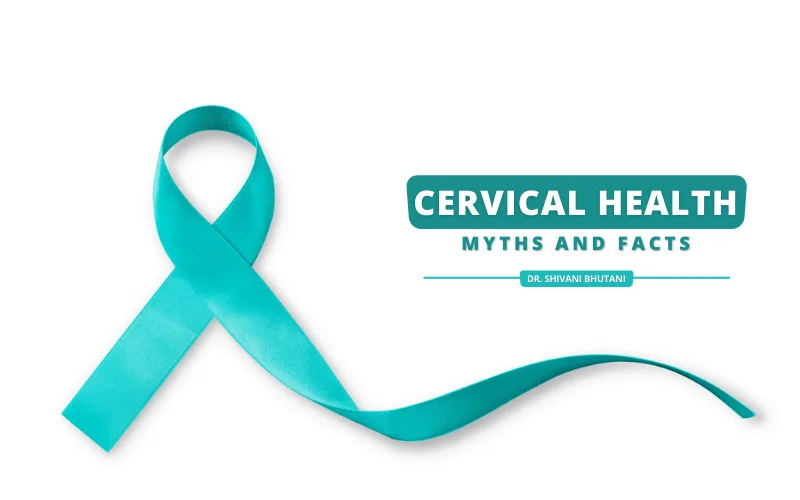Cervical Health – Myths and Facts
 Cervical Health
Cervical Health
Cervical Health – Myths and Facts
The cervix and its health are vital to the reproductive health and fertility of a woman. Yet, most women are either unaware or have little understanding of it. As a result, there are many myths attached to cervical health.
In this article, we will understand the role of the cervix and try to bust the myths attached to it.
What Are the Cervix and Its Function?
The cervix is the path or door that connects the vagina to the womb(uterus). It is roundish, fleshy, very small and shaped like pursed lips with a dimple in the centre.
Its small opening only expands to let discharge, menses and sperm pass through. Because of this function, no infections and materials( like tampons) can enter the uterus.
During pregnancy, it acts as a plug to keep the baby safe from infections.
1. Cervical Cancer is Hereditary: Myth
In numerous studies on women, breast and ovarian cancer are hereditary. They get carried over to the next generation, but not cervical cancer. It is because the latter is caused by a viral infection.
A young girl child till the age of 26 can be immunized against it by administering the HPV vaccine. If a woman has crossed that age, she can get a regular Pap Smear test done as a protection against it.
2. Cervical Cancer is the Most Common Cancer in Women: Myth
It is a total myth. Cancer of the cervix is not the most common cancer in women. The most prevalent cancers are of the breast and skin. Cervical cancer does have a high mortality rate though.
It is because it goes undetected due to a lack of awareness. It is treatable in the early stages, and the mortality rate is only 9 per cent. Its main cause is HPV or human papillomavirus.
Women must undergo Pap smear & HPV tests yearly during their regular gynaecological check-ups. There is also the HPV vaccine available, which is a great way to immunise yourself.
Discuss this with your gynaecologist Dr Shivani Bhutani, Ludhiana
3. Cervix Examination Tells You About Your Fertility: Myth
Well, a clinical cervical examination does indicate at what stage you are in your monthly menstrual cycle. There are hormonal changes during the menstrual cycle that affect the nature of the mucus present in the cervix.
When a female is ovulating, the mucus is thinner and stickier, the most fertile stage. Just after the period bleeding is over, it is thick & whitish like cream. So one can find the fertile days after examining the cervix.
However, it does not decide a woman’s ability to give birth naturally, only her fertile days in the month.
Fertility does not depend only on the menstrual cycle, but on many other factors like endometrial health, egg reserves, and fallopian tubal factors etc.
4. One Can Injure The Cervix During Sex: Fact
Well, it is true, though in rare cases. Depending on the anatomies of the male and female partner, very deep thrusting inside the vagina during conventional sex may bruise the cervix.
If the man’s penis is too big and the woman has a smaller passage ( in terms of length), she will feel pain and a sharp poking sensation which will persist.
Dr Shivani Bhutani, MD, Ludhiana, advises not to take this pain lightly. In some cases, not only the cervix can get bruised, but some of its tissue may get torn too.
You must make an appointment, and, consult your doctor for treatment as well as remedies to prevent it in future.
5. Condoms Can Prevent Cervical Infections: Fact
Using condoms is great for the health of your cervix. It safeguards you against unwanted pregnancies as well as sexually transmitted infections.
Both male and female condoms are good, but the latter is even better because they provide better coverage. They prevent both viral and bacterial infections from entering and protect the vulva, the vagina and the cervix.
When a woman has multiple partners, even more so. Infections like Human Papillomavirus and Chlamydia are very deadly and can cause cancer too.
We can’t say that condoms are 100 per cent effective, but they provide vital protection.
6. I Can’t Become a Mother After the Treatment of Cervical Cancer: Myth
With advances in medical techniques and IVF, there are plenty of options by which you can preserve your fertility until after the treatment of cervical cancer.
Depending on what stage the cancer is detected at, various procedures can be done for you to have your own biological child post-treatment. However, you must discuss all these options with your doctor before starting the treatments.
They can advise you better based on your particular case. Usually, treatment would involve surgery, chemotherapy, radiation and/or a hysterectomy.
In case the cervix is removed and the uterus is intact, the woman can carry the baby and deliver via a c- section.
Chemotherapy or radiation can harm the eggs and hormonal functions leading to infertility.
Before starting the therapies, you can opt for freezing your eggs, or even embryos, and use them later to become pregnant yourself or via a surrogate mother. This is possible with IVF.
Last word
Cervix is an important part of the reproductive anatomy of a woman and can be kept healthy with regular pap smear tests and gynaecologist visits.









